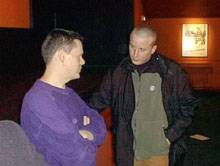 The tape-to-film transfer business has mushroomed rapidly since its first appearance, but with more transfer facilities coming on stream, internationally as well as in the UK and just as accessible, competition is hotting up and driving down prices. All of this is good news for the bigger budget filmmaker and as prices fall even lower, good news for low budget filmmakers, keen to get their films on 35mm for the big screen, as well. The companies specialising in this process and are encouraging low budget filmmakers to come to them with special discount deals that take up slack time at weekends or in the evenings, when junior operators can take over from seniors who can check work in progress during normal hours. More feature films are being transferred using this process after Avid editing, especially if they use computer generated imagery (CGI) or other special visual effects. However, tomorrow’s feature filmmakers are probably reading Netribution right now and making shorts, and these companies are very keen to make your acquaintance. With an eye to a joint future they want to build long-term relationships with new filmmakers, so they are opening doors. Last year, one of these companies, Digital Film at the Moving Picture Company, transferred 20 shorts to 35mm. They want to do more. The technology is improving all the time and helping drive down costs. The old CRT recorder used in this process used to take 35 seconds to scan each frame. That is down to just seven seconds per frame with the new Arrir. Costs now are much more affordable, half of what they were last year. Having said that, cheap is a relative term. In this case, relevant to the cost of the technology, what you are asking it to do and the skills of the people driving it for you. Costs may be half what they were for low budget work, but your short of three minutes or more will still set you back £500 a minute to transfer to 35mm. Then there’s the VAT, the Dolby fee and a few other bits and bobs that make for a sharp intake of your production accountant’s breath. iStill, this technology could be saving you money on the full cost of shooting in 35mm and editing on 35mm before screening on 35mm. We are talking thousands here, not just a few hundred quid. Film is still King of course and 35mm wears the crown. Nothing yet beats a handful of chemicals and some light and a lot of technology developed over a century. Put it this way. The sharpest, clearest TV image you can get at the moment is from High Definition Television, HDTV for short, which displays that image through 2,000 horizontal lines across the screen. That knocks seven bells out your humble PAL system with its 625 horizontals. If 35mm film had lines, and it doesn’t, it would carry its images on say, 4,000 of them, giving a very sharp very clear definition of the image. Apart from that, the electrochemical processes involved in film produce rich, vibrant colour tones, blacks that are black, whites that are white. Even though they are not true colours, as seen by the eye, they are assumed to be true. Taken to extreme, anyone watching Traffic thinks San Diego is blue, whereas Tijauna is brown. Mexico may not be as affluent as California, but why is concrete there dingy brown instead of Californian slatey-blue? Because of film stocks. Filmstock choice may be deliberate and for artistic reasons, but photochemicals on celluloid simply fool your brain. The movies have always been magic. Going digital just introduces a whole new line of trickery. 

|